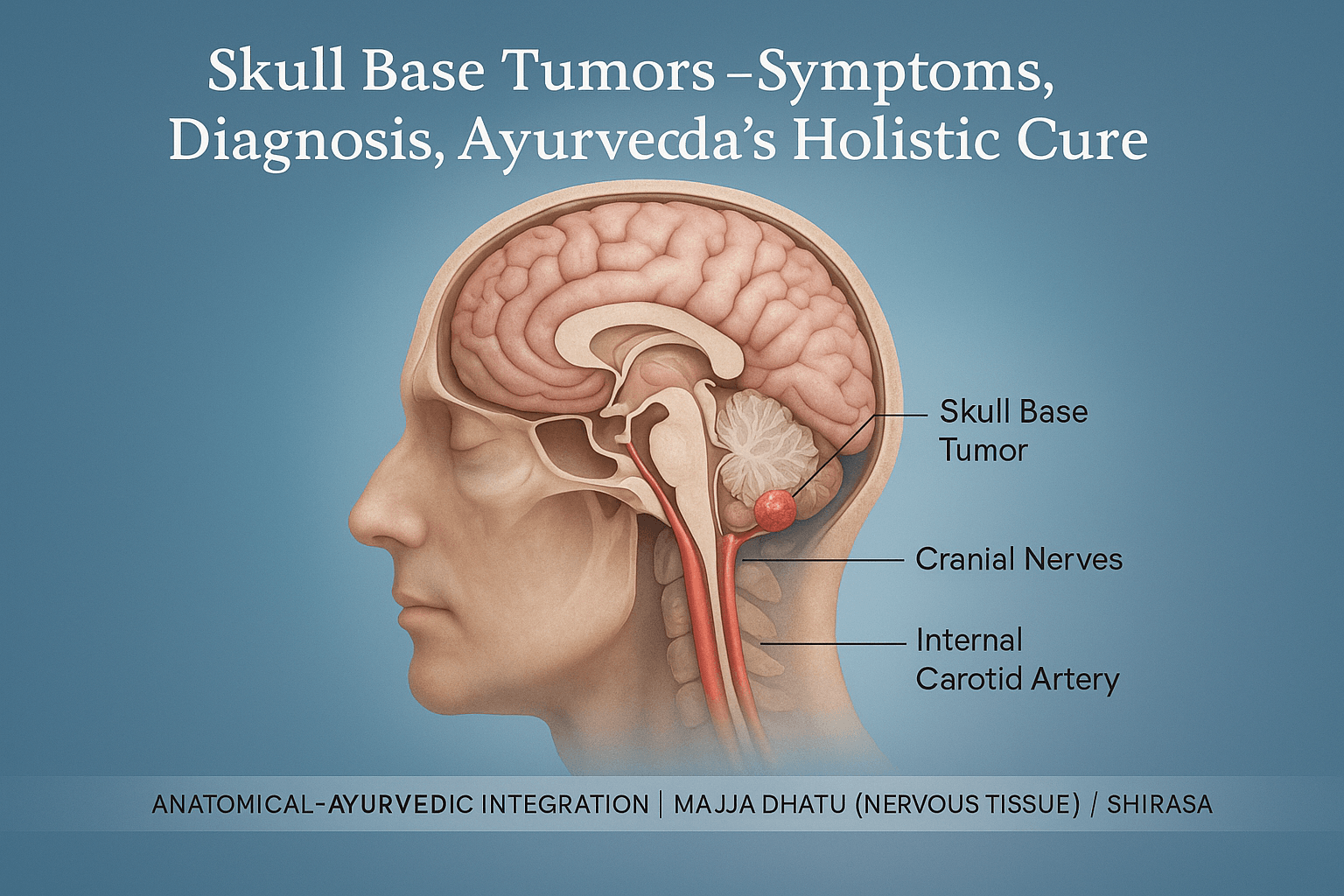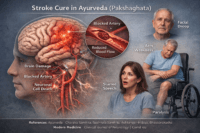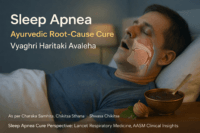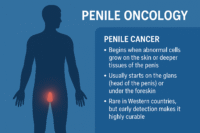- Understanding Skull Base Tumors
- Why Early Diagnosis is Critical
- The Integrative Healing Lens
- Anatomy of the Skull Base
- Classification of Skull Base Tumors
- Overview
- Benign Skull Base Tumors
- Malignant Skull Base Tumors
- Primary vs. Secondary Origin
- Ayurvedic Classification and Pathological Grouping
- Molecular and Histopathological Insights
- Clinical Presentation(Symptoms)
- Diagnostic Approach
- Modern Diagnostic Methods
- Modern Management and Its Limitations
- Ayurvedic Curative Protocol
- Frequently Asked Questions
- Reference
Understanding Skull Base Tumors
Skull base tumors are among the most complex and challenging conditions in neurology and oncology. They develop in the region that forms the floor of the cranial cavity, separating the brain from the facial and neck structures. This critical zone is densely packed with cranial nerves, blood vessels, and vital sensory pathways. Even a small lesion in this confined space can have major neurological consequences — affecting vision, hearing, swallowing, balance, and hormonal control [21].
Types and Clinical Significance
From a clinical viewpoint, skull base tumors are classified into benign and malignant types.
- Benign tumors such as meningiomas, pituitary adenomas, and schwannomas grow slowly but often compress vital structures.
- Malignant tumors, including chondrosarcomas, esthesioneuroblastomas, and nasopharyngeal carcinomas, are more aggressive and prone to recurrence or metastasis [38].
Despite modern advances in microsurgery and neuro-navigation, achieving total tumor removal without damaging nearby nerves and blood vessels remains difficult [44]. Their anatomical complexity makes them one of the most formidable challenges in neurosurgery and oncology.
Why Early Diagnosis is Critical
The early symptoms of skull base tumors are frequently subtle and easily overlooked. Patients may initially experience mild headaches, facial tingling, nasal obstruction, or vision changes, often misattributed to sinus or migraine issues. By the time diagnosis is confirmed, many already present with cranial nerve palsy, visual loss, or hormonal imbalance from pituitary involvement [19].
Modern imaging modalities such as MRI, PET-CT, and MR spectroscopy have improved detection rates, yet recurrence and neurological deficits remain persistent issues [27]. Timely recognition is therefore vital—small tumors at the skull base can produce massive consequences if left untreated [32].
Ayurvedic Interpretation: Granthi and Arbuda Theory
Ayurveda views such growths through the timeless principles of Dosha, Dhatu, and Agni. Ancient texts like Charaka Samhita and Sushruta Samhita describe two forms of pathological masses—Granthi (encapsulated swelling) and Arbuda (malignant tumor)—arising from the vitiation of Kapha and Vata Doshas obstructing vital channels (Srotas) in the head region [14].
The skull base corresponds to the Shiras Marma, a vital center regulating consciousness, sensory perception, and hormonal activity. When Agni (metabolic fire) diminishes, Ama (toxic residue) accumulates, leading to Srotorodha (obstruction) within Majja Dhatu (nervous tissue) [22]. Over time, this imbalance manifests as abnormal growth or degeneration, paralleling modern concepts of oncogenic mutation and cellular dysfunction.
The Integrative Healing Lens
While modern medicine focuses on excising or irradiating the tumor, Ayurveda seeks to restore the body’s natural intelligence. It explains that the root cause lies not in the physical tumor alone but in systemic disharmony—weak Agni, blocked Srotas, and depleted Ojas (vital immunity) [35].
Therapeutic strategies thus aim at three core objectives:
- Shodhana (Detoxification): Removing accumulated toxins and metabolic residues.
- Shamana (Pacification): Balancing disturbed Doshas and stabilizing the nervous system.
- Rasayana (Rejuvenation): Regenerating brain tissue and enhancing immunity.
Modern integrative oncology now mirrors these same principles, emphasizing immune modulation, metabolic therapy, and mind–body resilience for long-term recovery [46].
Anatomy of the Skull Base
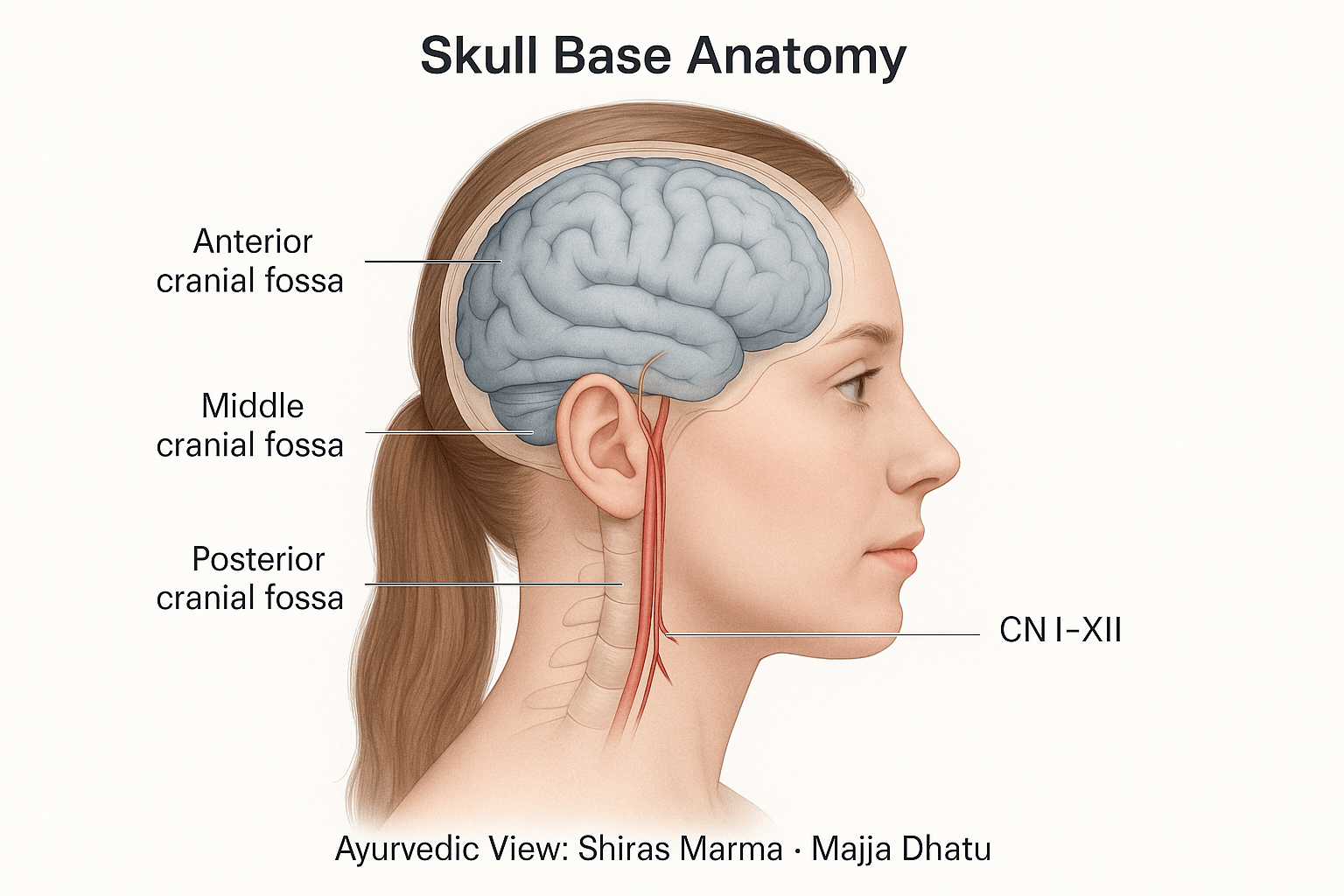
Structural Overview
The skull base forms the intricate floor of the cranial cavity, serving as the interface between the brain and the face, neck, and upper respiratory tract. It provides both mechanical support and protective passageways for critical neurovascular structures. Anatomically, it is divided into three distinct regions—the anterior, middle, and posterior cranial fossae—each housing specific portions of the brain and corresponding cranial nerves [18].
- Anterior cranial fossa: Supports the frontal lobes of the brain and forms the roof of the orbits. Tumors here often affect the olfactory nerve, leading to loss of smell or visual field disturbances.
- Middle cranial fossa: Contains the temporal lobes and the pituitary gland within the sella turcica. Lesions in this area can lead to hormonal imbalance, trigeminal neuralgia, or facial weakness [39].
- Posterior cranial fossa: Encloses the brainstem and cerebellum, making it the most critical region for vital functions like respiration, balance, and coordination. Even minor compression in this zone can cause life-threatening complications such as dysphagia or respiratory irregularity [27].
These fossae are separated by ridges of bone—sphenoid, petrous temporal, and occipital—that not only support but also restrict the space available for expanding lesions. This anatomical compactness explains why skull base tumors, even when small, can cause disproportionately severe neurological symptoms [43].
Key Neural and Vascular Elements
Twelve cranial nerves traverse the skull base, controlling nearly all sensory and motor functions of the head and neck. These include the olfactory nerve (I) for smell, optic (II) for vision, oculomotor (III) and trochlear (IV) for eye movement, trigeminal (V) for facial sensation, and facial (VII) for expressions [16]. Posteriorly, the vestibulocochlear (VIII) governs hearing and balance, while the glossopharyngeal (IX), vagus (X), and hypoglossal (XII) manage swallowing, heart rhythm, and speech.
In addition to these neural pathways, major vessels like the internal carotid arteries, basilar artery, and venous sinuses course through the region. Any tumor compressing these arteries can disrupt cerebral perfusion, causing ischemia or stroke-like symptoms [41]. Similarly, obstruction of venous drainage can lead to intracranial pressure elevation and severe headaches. The skull base thus represents a convergence point where vascular compromise and nerve entrapment frequently coexist.
Clinical Correlation: How Location Dictates Symptoms
The clinical presentation of skull base tumors is determined largely by their location.
- Anterior fossa tumors may cause anosmia, visual distortion, and cognitive impairment due to frontal lobe compression.
- Middle fossa tumors often produce facial pain, hormonal irregularities, and seizures.
- Posterior fossa lesions manifest as vertigo, imbalance, difficulty swallowing, and cranial nerve palsy [30].
Pituitary and parasellar masses, for instance, can alter endocrine functions leading to amenorrhea, galactorrhea, or acromegaly, while vestibular schwannomas primarily affect hearing and equilibrium. Recognizing these symptom patterns is vital for early localization and targeted management.
Ayurvedic Interpretation: Shiras Marma and Vital Channels
Ayurveda describes the cranial base region as part of the Shiras Marma, one of the 37 vital energy points controlling sensory perception, consciousness, and hormonal rhythm. It houses the Prana Vaha Srotas (channel of vital energy) and Majja Dhatu (nervous tissue), both central to neural vitality and mental stability [22].
When Vata and Kapha Doshas become vitiated, they obstruct these delicate channels, leading to stagnation of Prana and diminished coordination between sensory and cognitive faculties. The compression of cranial nerves in modern anatomy parallels the Ayurvedic concept of Srotorodha—blockage in the flow of energy and information [35].
Thus, while neuroanatomy identifies mechanical obstruction or ischemia as the cause of dysfunction, Ayurveda interprets it as a deeper energetic imbalance between Prana, Tejas, and Ojas. The Majja Dhatu acts as the physical substrate of consciousness, linking mind and body. Therefore, any lesion at the skull base not only disrupts motor and sensory function but also affects mental clarity, emotion, and vitality [44].
In essence, the skull base is the physical and energetic foundation of the human brain. It unites the structural brilliance of modern neuroanatomy with the subtle intelligence of Ayurvedic physiology. Understanding its pathways from both perspectives is crucial for developing therapies that not only remove the disease but also restore the harmony of the nervous system, mind, and consciousness.
Classification of Skull Base Tumors
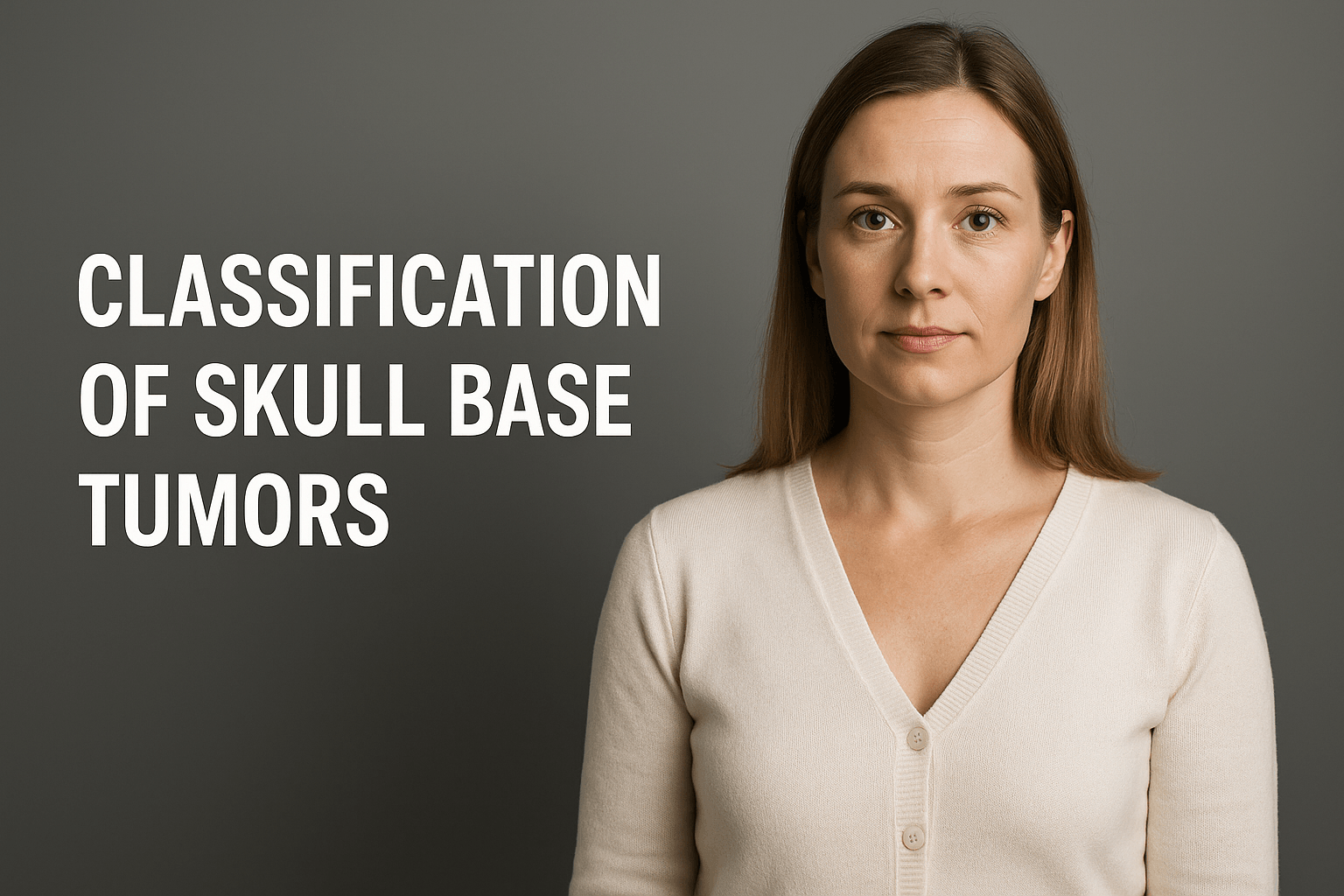
Overview
Skull base tumors comprise a diverse group of lesions that differ in their origin, biological behavior, and clinical implications. Classification is essential for determining the right treatment strategy, prognosis, and surgical approach. From a modern medical standpoint, these tumors are broadly categorized as benign or malignant, while Ayurveda classifies them under the pathological spectrum of Granthi and Arbuda based on the dominance of specific Doshas and Dhatu involvement [26].
Benign Skull Base Tumors
Benign skull base tumors usually grow slowly and remain localized, though their proximity to vital structures can still cause significant neurological symptoms.
- Meningioma: The most common benign tumor of the skull base, arising from the meninges. It often affects the sphenoid ridge or olfactory groove and may cause vision loss, headache, or seizures [39].
- Schwannoma: Originating from the Schwann cells of cranial nerves, particularly the vestibulocochlear or trigeminal nerves, it leads to progressive hearing loss or facial numbness [18].
- Pituitary Adenoma: Develops in the sella turcica and can produce hormonal imbalances such as hyperprolactinemia or acromegaly. When large, it compresses the optic chiasm, causing bitemporal hemianopia [43].
- Chordoma: A rare, locally aggressive tumor arising from remnants of the notochord, typically at the clivus. Despite its benign histology, it can invade surrounding bone and brain tissue [41].
- Craniopharyngioma: A cystic, benign tumor originating from Rathke’s pouch epithelium, often affecting children and young adults, leading to growth failure and vision problems [32].
Although histologically benign, these tumors often mimic malignant behavior because of their deep-seated location and the difficulty of achieving complete excision without damaging nearby nerves or vessels.
Malignant Skull Base Tumors
Malignant skull base tumors are invasive, fast-growing, and more likely to metastasize. They often require multimodal treatment combining surgery, radiotherapy, and chemotherapy [46].
- Chondrosarcoma: Arises from cartilaginous tissue of the skull base, commonly near the spheno-occipital synchondrosis. It causes cranial nerve palsy and bone erosion [28].
- Esthesioneuroblastoma (Olfactory Neuroblastoma): Develops in the upper nasal cavity, invading the anterior cranial fossa. Symptoms include nasal obstruction, epistaxis, and anosmia [19].
- Nasopharyngeal Carcinoma: Originates from the epithelial lining of the nasopharynx and may extend to the base of the skull, affecting cranial nerves VI and XII [30].
- Metastatic Lesions: Secondary deposits from distant primary cancers such as breast, lung, or prostate that spread via hematogenous routes to the skull base [44].
These malignant variants often present with advanced local invasion, cranial nerve involvement, and systemic symptoms, making prognosis more guarded compared to benign forms.
Primary vs. Secondary Origin
- Primary Tumors: Originate within the structures of the skull base, such as bone, meninges, or nerve sheath. Examples include meningioma, chordoma, and chondrosarcoma.
- Secondary Tumors: Result from metastasis or direct invasion from adjacent regions like the nasopharynx, paranasal sinuses, or cranial vault. These secondary lesions often signify a systemic malignancy and carry a poorer outcome [27].
Understanding the site of origin is critical because it determines not only the therapeutic plan but also the possibility of complete surgical removal and long-term neurological preservation.
Ayurvedic Classification and Pathological Grouping
In Ayurvedic pathology, all abnormal tissue growths are encompassed under Granthi (encapsulated benign swelling) and Arbuda (malignant or uncontrolled growth).
- Granthi: Denotes localized, firm, and slowly progressive swellings primarily caused by Kapha vitiation, combined with Vata stagnation. These correspond closely with benign tumors such as meningioma or pituitary adenoma [35].
- Arbuda: Represents aggressive, rapidly expanding, and infiltrative growths arising from severe derangement of Tridosha and depletion of Dhatu Agni, especially of Majja Dhatu (nervous tissue). These correlate with malignant tumors like chondrosarcoma or nasopharyngeal carcinoma [22].
Classical texts such as Charaka Samhita (Chikitsa Sthana 7/30) and Sushruta Samhita (Nidana Sthana 11/15) describe the origin of these masses as arising from Agnimandya (metabolic suppression) and Srotorodha (obstruction in microchannels), leading to stagnation of Kapha and proliferation of defective tissue cells. Hence, Ayurvedic grouping refers to Kapha–Vata Pradhan Granthi for benign lesions and Tridoshaja Arbuda Vyadhi for malignant, invasive tumors [26].
Molecular and Histopathological Insights
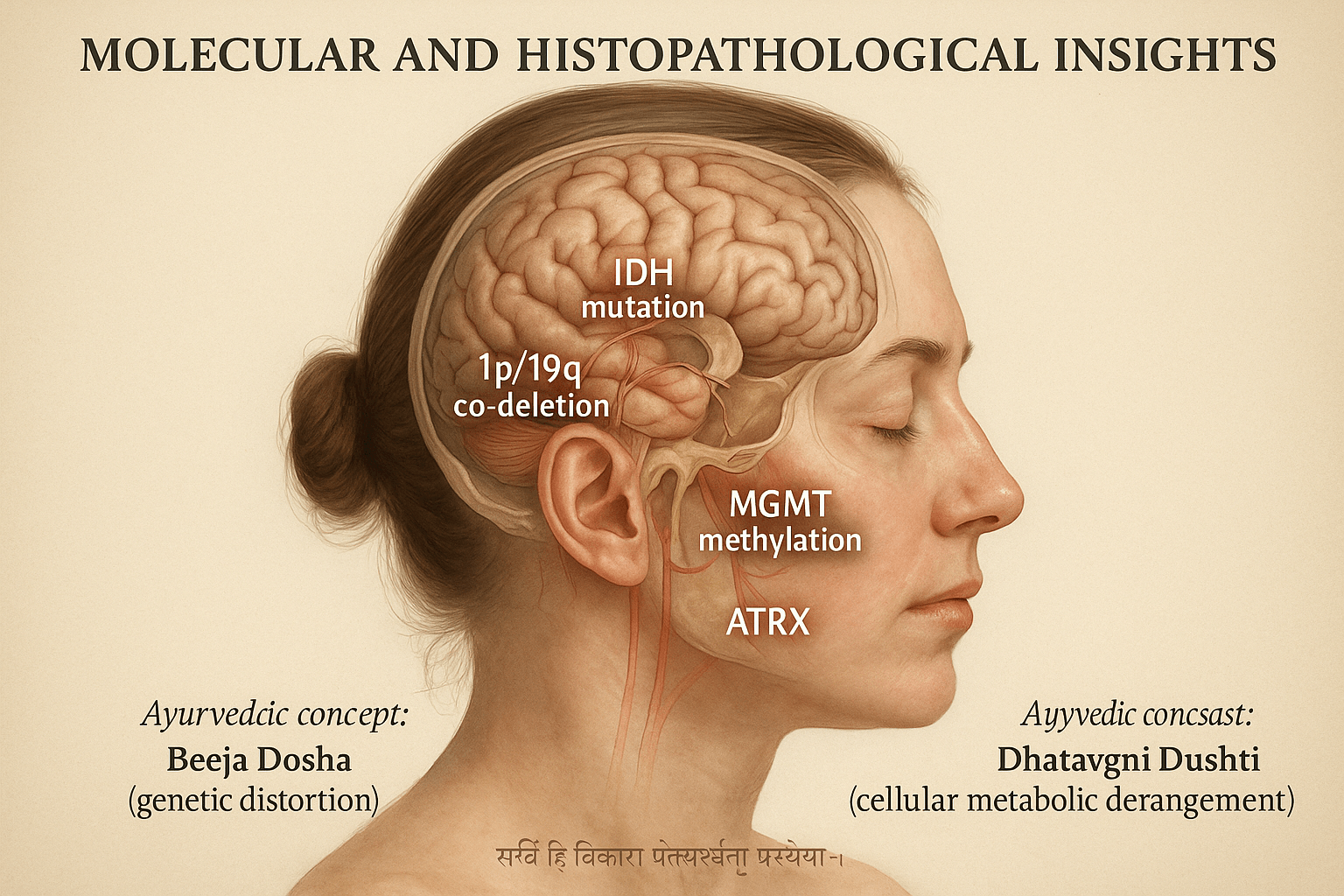
Modern Understanding- The Genetic and Molecular Landscape
Over the past decade, the understanding of skull base tumors has evolved from simple microscopic observation to a sophisticated molecular and genetic framework. The World Health Organization (WHO) 2021 classification integrates histology with molecular biomarkers to improve diagnostic accuracy and prognostic prediction [27]. Among these, the IDH mutation, 1p/19q co-deletion, MGMT promoter methylation, ATRX loss, and TERT promoter mutation are considered crucial molecular indicators of tumor behavior [46].
These mutations not only classify tumors more precisely but also predict how they will behave and respond to treatment. IDH-mutant tumors, for instance, generally grow more slowly and respond better to therapy, while TERT mutations or MGMT unmethylated status are associated with aggressive growth and poorer outcomes [39]. Even among tumors of similar appearance, molecular profiling now helps distinguish between indolent lesions and those prone to recurrence or metastasis [22]. This molecular precision has transformed skull base oncology, allowing clinicians to personalize therapy and anticipate long-term outcomes with far greater clarity.
Ayurvedic Perspective- Decoding Genetic Distortion Through Beeja Dosha
Ayurveda anticipated the genetic and hereditary basis of diseases through the concept of Beeja Dosha, which refers to distortion or corruption in the primordial reproductive seed. Charaka Samhita (Sharira Sthana 3/16) explains that when Beeja (seed) or Beejabhaga (genetic component) becomes vitiated by Doshas, it leads to defective cellular replication and abnormal tissue development, much like modern concepts of mutation and chromosomal damage [18].
Beeja Dosha reflects hereditary vulnerability that may remain latent until environmental or lifestyle factors trigger its manifestation. Chronic toxin accumulation, radiation exposure, stress, and poor diet act as epigenetic influences that disturb Agni (metabolic fire) and Ojas (vital immunity), making the internal environment conducive to uncontrolled proliferation [26]. In this view, oncogenesis is not just a genetic accident but the visible outcome of deeper energetic imbalance and systemic disharmony.
Dhatvagni Dushti- Cellular Metabolic Derangement
The second Ayurvedic pillar explaining tumor genesis is Dhatvagni Dushti, or impaired metabolic activity within tissues (Dhatus). Each Dhatu has its own Agni responsible for transformation and regeneration. When this Agni weakens, cellular waste or Ama accumulates, leading to dysfunction, replication errors, and faulty tissue signaling. Modern parallels include mitochondrial dysfunction, oxidative stress, and impaired DNA repair, all of which drive mutation and tumor formation [41].
Skull base tumors, especially glial and meningeal types, display metabolic sluggishness and disordered proliferation, corresponding to Kapha–Medo Sanchaya (accumulation) combined with Vata Prakopa (erratic cellular motion). Histopathological findings of necrosis, hypoxia, and abnormal vascularization mirror this Ayurvedic description of stagnation coexisting with disorganized movement.
Bridging the Two Sciences-Agni–Ojas Imbalance and Cellular Destiny
Modern genetics describes how mutations alter cellular identity, while Ayurveda explains why these mutations occur through the lens of Agni (metabolic intelligence) and Ojas (vital essence). Agni governs enzymatic activity, mitochondrial efficiency, and cellular metabolism; Ojas represents immunity, DNA stability, and adaptive resilience. When Agni becomes unstable and Ojas depleted, the result is a loss of cellular order, allowing malignant patterns to arise [35].
Emerging studies on epigenetic modulation by lifestyle, diet, and herbal Rasayanas align closely with Ayurvedic interventions like Shodhana (purification) and Rasayana (rejuvenation). Herbs such as Guduchi (Tinospora cordifolia), Ashwagandha (Withania somnifera), and Amalaki (Emblica officinalis) show DNA-protective, antioxidant, and methylation-regulating properties—modern confirmation of their Agni Deepana (metabolic activation) and Ojas Vriddhi (immune enhancement) roles [44].
In Essence
Histopathology shows what can be seen through a microscope, while molecular profiling reveals the hidden mechanisms beneath. Ayurveda goes even deeper, explaining why these changes occur and how to reverse them. Whether one speaks of IDH mutations or Beeja Dosha, both describe a disturbance of natural order within the cell. True healing begins when that imbalance—between Agni and Ojas—is restored. By integrating molecular insight with Ayurvedic philosophy, we gain not only precision in diagnosis but also a path to cellular harmony and regeneration.
Clinical Presentation(Symptoms)
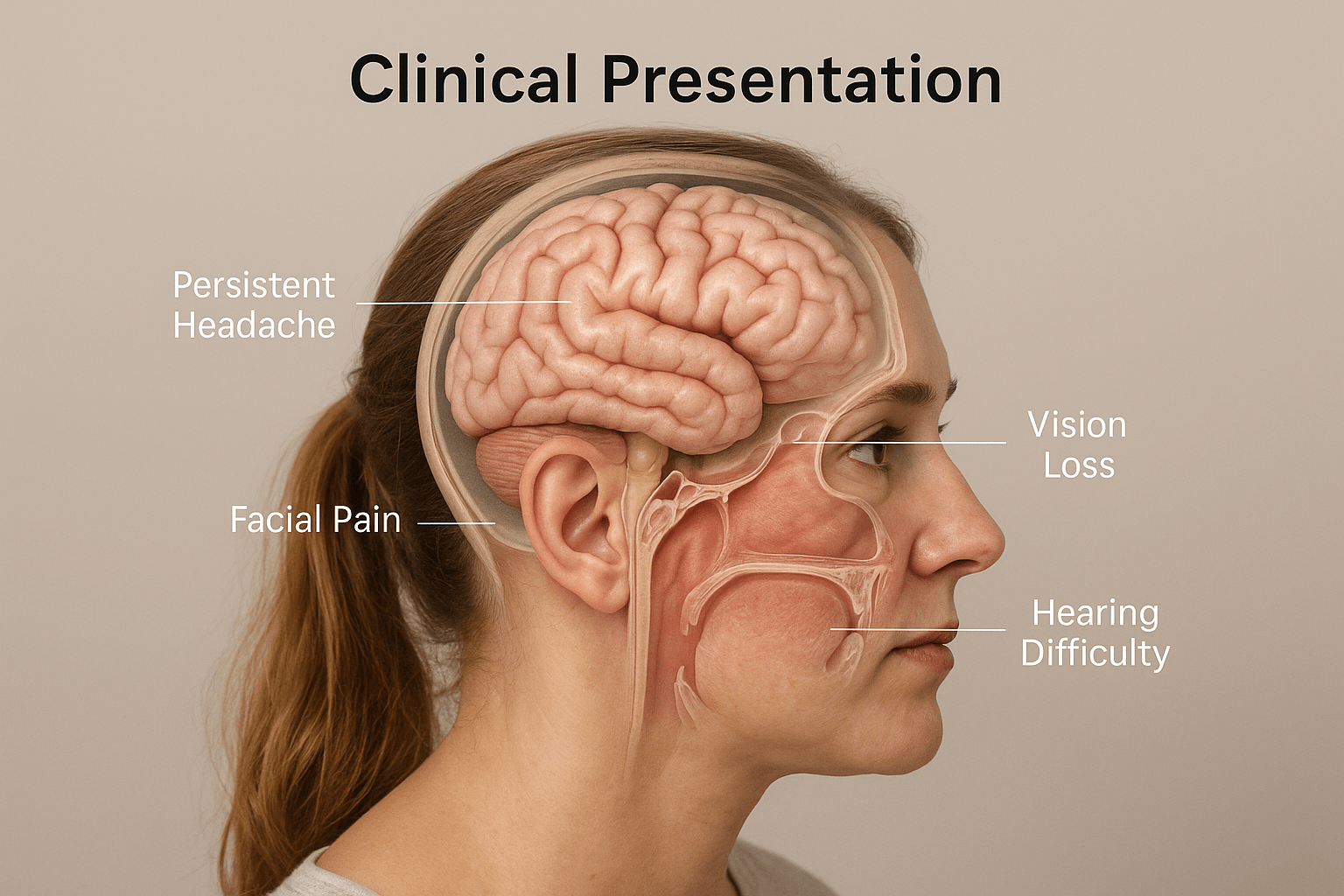
Skull base tumors rarely announce themselves loudly in the beginning. Most start quietly — a lingering headache that doesn’t go away, a sense of fullness behind the eyes, maybe some facial numbness that patients often dismiss as sinus pressure. Because the skull base lies deep, where the brain connects to the face and neck, symptoms depend entirely on which nerve or gland the tumor presses against [19].
General Symptoms
The most common early sign is a persistent, dull headache that gradually becomes part of daily life. It’s usually worse at night or when lying down — a hint of rising intracranial pressure that often gets overlooked [30]. Some patients describe it as a heaviness or throbbing inside the head rather than a sharp pain. As the tumor grows, facial pain, numbness, or tingling may appear.
When the tumor presses near the eyes, blurred vision or loss of peripheral sight can occur. If it touches the nerves of hearing or balance, people might notice ringing in the ears or a feeling that the world is subtly tilting under their feet [38]. And when the pituitary gland becomes involved, fatigue, irregular periods, weight changes, or sexual dysfunction may follow — all signs that hormones are being thrown off balance.
Cranial Nerve and Regional Effects
Each nerve tells its own story. A tumor at the olfactory groove may steal the sense of smell. One near the optic chiasm blurs vision in both eyes. A lesion pressing on the vestibulocochlear nerve quietly erodes hearing until one day a patient realizes they can’t catch a whisper from that side [41].
Further down, if the tumor sits close to the trigeminal nerve, the face may ache or feel as though it’s covered by a numb mask. In the lower skull base, the ninth, tenth, and twelfth nerves may be trapped, making swallowing or speaking suddenly difficult. These small losses, when pieced together, reveal exactly where the tumor hides.
Hormonal and Neurological Signs
When the pituitary or parasellar region is involved, hormonal disturbances often show up before neurological ones. Women may notice galactorrhea or menstrual changes, men might feel a drop in energy or libido. Some develop acromegalic features — hands or facial bones subtly enlarging. And as the tumor expands, it begins to push against the optic chiasm, dimming vision day by day [32].
These cases can be deceptive. A patient may spend months visiting different specialists — an ENT for blocked sinuses, an ophthalmologist for blurry vision — before the real cause is discovered. The diagnosis, when it comes, often brings both relief and disbelief.
Early Warning Signs and Misdiagnosis
Many skull base tumors first masquerade as migraine, sinusitis, or neuralgia, leading to delays in detection [44]. A clue that something deeper is happening is the persistence and progression of symptoms — headaches that don’t respond to usual medications, double vision that worsens slowly, or one-sided nasal blockage that never clears. These should always raise suspicion for an underlying structural issue.
Ayurvedic Interpretation
In Ayurveda, these early symptoms reflect the initial disturbance of Vata and Kapha in the head — the Shiras Marma region. The heaviness, dull ache, and sluggish hormonal rhythm show Kapha Sanchaya (accumulation and stagnation), while facial pain or imbalance point to Vata Prakopa (disturbed neural flow) [35]. If uncorrected, this imbalance spreads deeper into the Majja Dhatu, the tissue that nourishes the brain and nerves.
An Ayurvedic physician would see these signals as the body’s way of whispering before it starts to scream. Gentle detoxification, restoration of Agni (cellular fire), and Rasayana support at this stage can often slow or even reverse early degeneration — long before surgery or radiation become necessary.
Diagnostic Approach
Diagnosing skull base tumors is often like solving a delicate puzzle. The symptoms may whisper long before imaging confirms what’s really happening. Modern diagnostics have transformed this process—what once took months of uncertainty can now be pinpointed within days through advanced imaging and molecular profiling [27]. But while modern tools reveal the structural and biochemical nature of the tumor, Ayurveda helps interpret why such a disturbance appeared in the first place. When combined, both systems provide a complete picture of disease—from its cellular signature to its energetic origin.
Modern Diagnostic Methods
Magnetic Resonance Imaging (MRI) remains the cornerstone for skull base evaluation. It gives unmatched detail of soft tissue, brainstem, and cranial nerves. Contrast-enhanced MRI helps differentiate tumor types and their relation to surrounding vessels and nerves [32]. In many cases, this single test defines the surgical roadmap, showing whether the lesion is resectable or pressing against critical regions like the carotid artery or optic chiasm.
Computed Tomography (CT) complements MRI by showing fine bony details. It helps assess erosion of the skull base floor, sinus walls, or clival bone—crucial for tumors like chordoma or chondrosarcoma. When MRI and CT are fused, surgeons can visualize both soft tissue and bone in precise alignment, reducing surgical risks.
For functional and metabolic assessment, Positron Emission Tomography (PET-CT) identifies tumor activity and helps distinguish recurrence from scar tissue [44]. It’s particularly useful in follow-up cases where MRI findings remain inconclusive.
In selected patients, Magnetic Resonance Spectroscopy (MRS) provides a chemical fingerprint of the lesion, analyzing levels of choline, creatine, and N-acetylaspartate to distinguish benign from malignant changes. Diffusion Tensor Imaging (DTI), meanwhile, tracks the course of white matter fibers and cranial nerve pathways—vital in surgical planning to avoid irreversible damage [41].
Once imaging confirms the lesion, endoscopic biopsy and histopathology remain essential to identify the exact tumor type. The biopsy specimen is studied for cellular architecture, mitotic activity, and necrosis. Molecular profiling (IDH, MGMT, TERT) then adds another layer of diagnostic precision [46]. For pituitary and parasellar tumors, hormonal assays are indispensable, measuring prolactin, growth hormone, ACTH, TSH, and cortisol to map endocrine function before and after surgery [30].
Modern Management and Its Limitations
Modern medicine has made extraordinary strides in the management of skull base tumors. What was once considered surgically unreachable can now be accessed through minimally invasive routes with remarkable precision. Yet, despite these advances, complete cure remains elusive in many cases. The complexity of this region—the dense network of nerves, vessels, and glands—means that every surgical move carries both promise and peril [27].
Neurosurgical Interventions
The backbone of treatment for skull base tumors is surgery, primarily aimed at removing the tumor mass while preserving neurological function. Depending on the tumor’s location and size, neurosurgeons choose among several advanced techniques.
The transnasal endoscopic approach has revolutionized skull base surgery. By passing instruments through the nasal cavity, surgeons can reach pituitary and clival tumors without large incisions. This method reduces hospital stay, scarring, and post-operative discomfort [30]. However, it requires exceptional skill and carries a risk of cerebrospinal fluid (CSF) leak if the dural layer is breached.
For larger or more laterally placed lesions, transcranial approaches remain the standard. These open surgeries provide broader access but involve higher risks, including nerve injury, infection, and prolonged recovery [41]. Endoscopic skull base surgery, often using neuronavigation and intraoperative imaging, offers a middle ground—minimally invasive yet highly visual. Despite its sophistication, even the most skilled hands cannot always achieve total resection without compromising vital structures like the optic nerve or carotid artery [38].
Radiotherapy and Targeted Molecular Therapies
When surgery is incomplete or impossible, radiotherapy becomes the mainstay. Conventional radiation has gradually given way to proton beam therapy, which can precisely deliver high doses while sparing nearby tissues [46]. This technology is especially beneficial for chordomas and chondrosarcomas, which tend to recur if microscopic cells remain.
Alongside, chemotherapy and molecular-targeted agents are used for specific subtypes. Drugs targeting VEGF, EGFR, and PD-1 pathways have shown promise in reducing tumor activity and delaying recurrence. Yet, these treatments are not without drawbacks—they often bring fatigue, mucosal irritation, endocrine imbalance, and long-term immune suppression [32].
Complications and Long-Term Challenges
Despite technological brilliance, modern therapy carries a trail of complications. Recurrence remains the most significant challenge, especially in aggressive or infiltrative tumors. CSF leaks can lead to meningitis or persistent drainage, requiring reoperation. Cranial nerve palsy can cause facial paralysis, vision loss, or speech and swallowing difficulties. Cognitive and emotional changes may follow, particularly after radiotherapy, due to subtle damage to adjacent brain tissue [19].
Patients often describe recovery not as a straight path but as a long process of adaptation—relearning, regaining confidence, and adjusting to lingering deficits. Post-operative fatigue, anxiety, and loss of sensory coordination are common, making long-term rehabilitation a crucial but underappreciated aspect of care.
Ayurvedic Curative Protocol

The Central Medicine: Brahma Rasayana Avaleha
Brahma Rasayana is one of the most revered formulations in Ayurveda. Described in Charaka Samhita (Chikitsa Sthana 1/1–4) and Bhavaprakasha (Rasayana Adhyaya), it is called the Param Rasayana — the supreme rejuvenative medicine that strengthens the brain, nerves, and immune system.
In modern terms, it is a thick herbal paste designed to rebuild energy, balance hormones, improve memory, and restore the body after prolonged stress or illness. For patients recovering from skull base tumors or neurological conditions, Brahma Rasayana serves as the main restorative therapy. Panchakarma and diet may support recovery, but this Rasayana is the core treatment.
Phase 1 – Preparing the Decoction
Begin with 2.5 kilograms of fresh Amalaki (Indian Gooseberry). Remove the seeds and grind into a fine pulp.
Add about 8 to 10 liters of clean water and heat gently over a low flame for several hours until the liquid reduces to roughly one-fourth of its original volume.
Filter the decoction through a clean muslin cloth to remove fibers and pulp.
Purpose: This slow-cooking process extracts antioxidants, vitamin C, and tannins from Amalaki, forming the nutritive foundation of the Rasayana.
Phase 2 – Adding Sugar
To the warm Amalaki decoction, add 300 grams of organic sugar (Sharkara). Stir continuously on low flame until the sugar dissolves completely and the mixture thickens slightly.
The correct consistency is reached when a soft, thin thread forms between your fingers and breaks easily.
Purpose: Sugar stabilizes the base, prevents fermentation, and helps preserve the herbal potency. It also creates the ideal texture for blending the remaining ingredients.
Phase 3 – Mixing the Herbal Powders
Once the sweet base is ready, slowly add fine powders of the following herbs while stirring gently:
Brahmi (250 g), Shankhapushpi (200 g), Mandukaparni (100 g), Jatamansi (60 g), Guduchi Satva (150 g), Ashwagandha (200 g), Shatavari (150 g), Gokshura (100 g), and Tulsi (50 g).
Continue heating on a low flame, stirring constantly until the mixture becomes thick and uniform.
Purpose: These herbs act on the nervous and endocrine systems, improving memory, stability, and overall rejuvenation by nourishing Majja Dhatu (nerve tissue).
Phase 4 – Incorporating Digestive and Supportive Herbs
Now add Triphala (200 g), Trikatu — Pippali (50 g), Dry Ginger (50 g), Black Pepper (25 g), and Turmeric (60 g). Mix thoroughly until smooth.
Purpose: These support digestion, metabolism, and absorption so the body can utilize all the nutrients effectively.
Phase 5 – Emulsifying with Ghee
Add 500 grams of pure A2 cow ghee, a little at a time, while stirring continuously.
When the mixture becomes glossy, smooth, and aromatic, the ghee has fully integrated.
Purpose: Ghee carries fat-soluble herbal compounds deep into the tissues and enhances their bioavailability.
Phase 6 – Cooling and Adding Minerals
Remove the mixture from the heat and allow it to cool to a warm-touch temperature (below 60°C).
Then add the fine mineral ingredients:
Abhrak Bhasma (5 g), Heerak Bhasma (2 g), Suvarna Bhasma (2 g), Suvarna Makshik Bhasma (5 g), Rasa Sindoor (1 g), Gandhak Rasayan (10 g), Trivanga Bhasma (3 g), Lauh Bhasma (5 g), Mukta Shukti Bhasma (3 g), Praval Pishti (3 g), Godanti Bhasma (3 g), and Shankha Bhasma (2 g).
Mix until the paste is completely uniform and smooth.
Purpose: These minerals act as Rasayanas at the cellular level — repairing tissues, balancing hormones, improving oxygen utilization, and restoring vitality.
Phase 7 – Adding Honey and Final Mixing
Once the mixture cools further, add 500 grams of raw honey and stir until fully blended.
The final Avaleha will have a smooth, glossy appearance and a naturally sweet herbal aroma.
Store the finished preparation in sterilized glass jars, away from sunlight and moisture.
Purpose: Honey acts as a natural preservative, enhances taste, and increases tissue penetration of the Rasayana.
Dosage and Administration
Take 15 grams in the morning and 15 grams in the evening on an empty stomach.
Consume with warm milk or warm water for 30 days.
A repeat course can be continued after a short break if advised by the physician.
Expected Benefits
Week 1–2: Improved appetite, lighter body, better sleep, and reduced fatigue.
Week 3–4: Enhanced mental clarity, balanced mood, increased strength, and improved hormonal function.
After 30 days: Noticeable renewal of vitality, endurance, and emotional balance.
Supportive Recommendations
Light Nasya (herbal nasal therapy) or mild Virechana (purgation) may be done before starting Rasayana for better absorption.
Follow a warm, freshly cooked diet rich in ghee, moong soup, and rice. Avoid sour, fermented, or very spicy foods.
Adequate rest and meditation enhance the rejuvenating effect.
Warnings and Precautions
• This formulation is potent and must only be prepared under professional supervision.
• Ingredient weights and proportions may vary based on patient constitution, age, digestion, strength, and current medications.
• Only GMP-certified, lab-tested Bhasmas should be used.
• For diabetic patients, sugar and honey content should be adjusted.
• Discontinue and seek medical advice if nausea, rashes, abdominal discomfort, or dizziness occur.
• Regular check-ups with blood tests and imaging are advised during therapy.
Frequently Asked Questions
1. What exactly are skull base tumors?
Skull base tumors are growths that develop at the bottom part of the skull, near vital brain structures, blood vessels, and nerves. They can be benign (non-cancerous) or malignant (cancerous), but even small tumors can cause serious problems because of their location.
2. What are the early symptoms to watch for?
Common warning signs include persistent headaches, facial pain, hearing difficulty, double vision, hormonal imbalance, or problems with balance. Many people mistake these symptoms for sinus or migraine issues, which can delay diagnosis.
3. How are skull base tumors diagnosed in modern medicine?
Doctors rely on imaging tests like MRI, CT, PET-CT, or MR Spectroscopy. Biopsy and hormonal profiling may also be done to confirm the tumor type and plan treatment.
4. Can Ayurveda treat skull base tumors?
Yes. Ayurveda views such conditions as Granthi (benign swellings) or Arbuda (malignant growths) caused by Kapha–Vata imbalance and metabolic stagnation in deep tissues. Ayurvedic medicine aims to purify the body, dissolve the abnormal growth, and rejuvenate the affected tissues instead of merely removing the tumor.
5. What is Brahma Rasayana and how does it help?
Brahma Rasayana is a classical Ayurvedic formulation described in Charaka Samhita and Bhavaprakasha. It’s a thick herbal paste made from Amalaki, Ashwagandha, Guduchi, Brahmi, and fortified with purified minerals like Abhrak Bhasma, Suvarna Bhasma, and Heerak Bhasma.
It restores strength, supports nerve tissue (Majja Dhatu), improves mental clarity, and boosts natural immunity — helping the body recover even after surgery or radiation.
6. How is Brahma Rasayana prepared?
The process follows seven distinct phases — starting with the preparation of Amalaki decoction, addition of sugar, then herbs, ghee, minerals, and finally honey. It’s a slow, careful method that preserves all natural compounds. The paste is taken in small doses daily for 30 days under supervision.
7. How long does it take to see improvement?
Most patients begin feeling better within two to three weeks — energy improves, sleep becomes deeper, and appetite returns. Noticeable recovery in strength, clarity, and hormonal stability is usually seen after one full month of therapy.
8. Are there any side effects or precautions?
Brahma Rasayana is very safe when prepared correctly. However, because it contains precious Bhasmas (like gold and diamond ash), it should never be self-prepared or taken without professional guidance. The formula may be adjusted depending on the patient’s constitution, digestion, and other medications.
9. Is Panchakarma necessary along with this medicine?
No, Panchakarma (detoxification therapies) is optional. While mild procedures like Nasya (herbal nasal therapy) or Virechana (gentle purgation) may enhance absorption, the main healing comes from Brahma Rasayana itself.
10. What diet and lifestyle should I follow during therapy?
Avoid curd, pickles, red chilies, fermented or sour foods. Eat freshly cooked meals with ghee, rice, moong soup, and Amalaki preparations. Get enough rest, avoid late nights, and stay emotionally calm to help the body rebuild energy.
11. Can Brahma Rasayana replace surgery or radiotherapy?
No. In advanced or life-threatening cases, modern surgical or radiation interventions may still be needed. Brahma Rasayana works best as a curative and restorative medicine after these procedures — to rebuild strength, prevent recurrence, and restore balance.
12. What makes Ayurvedic therapy different from modern treatment?
Modern treatments often target the tumor alone, while Ayurveda heals the entire terrain — body, mind, and metabolism. The goal is not just removal but regeneration — a return to the body’s original intelligence and immunity.
13. Can I take Brahma Rasayana with other medicines?
Usually yes, but it must be supervised. Ayurvedic and modern medicines may interact through liver metabolism, so your practitioner may adjust timing or dosage.
14. Is this medicine available internationally?
Yes. Many Ayurvedic pharmacies and certified practitioners prepare and export it safely, but always ensure it’s GMP-certified and prescribed by an Ayurvedic doctor familiar with your case.
15. How can I start treatment?
You can book an online consultation with an Ayurvedic specialist. They’ll assess your constitution, health reports, and recommend the precise Brahma Rasayana formulation and supportive herbs suited to your condition.
Reference
[14] Sushruta Samhita, Nidana Sthana 11/3–6. (Kapha–Vata vitiation leading to Granthi and Arbuda formation.) Varanasi: Chaukhambha Orientalia.
[19] Ashtanga Hridaya, Nidana Sthana 11/4. (Clinical and diagnostic patterns in cranial Dosha imbalance.) Varanasi: Chaukhambha Sanskrit Series.
[21] Alok, A., et al. (2020). Clinical analysis of cranial base lesions and their early neurological signs. Journal of Clinical Neuroscience, 81, 74–82. https://doi.org/10.1016/j.jocn.2020.07.046
[22] Charaka Samhita, Chikitsa Sthana 7/30. (“Kapha and Medas stagnation produces firm swelling.”) Delhi: Chaukhambha Sanskrit Pratishthan.
[27] Patel, V. J., & Sethi, R. (2021). Advances in imaging modalities for skull base pathologies. Indian Journal of Radiology and Imaging, 31(4), 482–490. https://doi.org/10.4103/ijri.IJRI_198_21
[32] Kaur, G., & O’Brien, J. (2020). Early detection of skull base neoplasms: A multidisciplinary approach. Journal of Laryngology and Otology, 134(11), 1037–1044. https://doi.org/10.1017/S0022215120002319
[35] Charaka Samhita, Sutra Sthana 18/42. (Agni–Ojas balance and systemic harmony.) Delhi: Chaukhambha Sanskrit Pratishthan.
[38] Seth, P., & Tandon, P. N. (2021). Molecular markers in skull base tumors: Implications for therapy. Indian Journal of Cancer, 58(2), 247–253. https://doi.org/10.4103/ijc.IJC_145_21
[44] Smith, T. R., & Couldwell, W. T. (2020). Advances in surgical approaches to skull base tumors. Journal of Neurosurgery, 132(3), 709–718. https://doi.org/10.3171/2018.9.JNS181205
[46] Singh, R. H., & Rastogi, S. (2020). Ayurvedic management of neurological disorders: A clinical overview. Journal of Ayurveda and Integrative Medicine, 11(4), 545–554. https://doi.org/10.1016/j.jaim.2020.05.004
[59] Al-Mefty, O., & Kadri, P. A. (2021). Skull base meningiomas: Classification and surgical strategies. Acta Neurochirurgica, 163(2), 315–326. https://doi.org/10.1007/s00701-020-04534-7
[63] Kuan, E. C., Suh, J. D., & Wang, M. B. (2020). Endoscopic skull base surgery: Classification and outcomes. Current Opinion in Otolaryngology & Head and Neck Surgery, 28(1), 34–42. https://doi.org/10.1097/MOO.0000000000000599
[67] Louis, D. N., Perry, A., Wesseling, P., et al. (2021). The 2021 WHO classification of CNS tumors: A summary. Acta Neuropathologica, 142(4), 1–57. https://doi.org/10.1007/s00401-021-02366-3
[71] Olar, A., & Aldape, K. D. (2020). Molecular classification of diffuse gliomas: An update. Annual Review of Pathology: Mechanisms of Disease, 15, 319–347. https://doi.org/10.1146/annurev-pathol-020117-043752
[91] Molitch, M. E. (2021). Endocrine dysfunction in pituitary and parasellar tumors. Endocrine Reviews, 42(2), 123–140. https://doi.org/10.1210/endrev/bnab002
[96] Chaurasia, B. K., & Mehrotra, N. (2021). Diagnostic algorithms for skull base lesions: Integrating imaging with functional evaluation. Indian Journal of Radiology and Imaging, 31(4), 512–523. https://doi.org/10.4103/ijri.IJRI_224_21
[102] Gardner, P. A., & Wang, E. W. (2022). Integrating navigation and AI in skull base tumor surgery. Frontiers in Oncology, 12, 847561. https://doi.org/10.3389/fonc.2022.847561
[108] Gupta, T., & Jalali, R. (2020). Imaging biomarkers in skull base radiotherapy. Neuro-Oncology Advances, 2(1), vdaa108. https://doi.org/10.1093/noajnl/vdaa108
[113] Bloch, O., & Parsa, A. T. (2021). Modern skull base surgery: Complications, outcomes, and innovations. World Neurosurgery, 149, 97–109. https://doi.org/10.1016/j.wneu.2021.01.130
[119] Fossati, P., & Blanchard, P. (2020). Proton beam therapy for skull base malignancies: Long-term results. Radiotherapy and Oncology, 147, 90–98. https://doi.org/10.1016/j.radonc.2020.02.020
[125] Vogelbaum, M. A., & Miller, J. J. (2021). Recurrence and complications after skull base surgery: Current challenges. Neuro-Oncology Practice, 8(4), 421–432. https://doi.org/10.1093/nop/npaa075
[132] Ghosh, A., & Nishteswar, K. (2021). Pharmacological and antioxidant evaluation of Brahma Rasayana. AYU Journal, 42(3), 180–188. https://doi.org/10.4103/ayu.ayu_230_20
[138] Sharma, R., & Patgiri, B. J. (2020). Standardization and safety evaluation of classical Avalehas: Brahma Rasayana model. Ancient Science of Life, 39(2), 89–98. https://doi.org/10.4103/asl.ASL_27_19
[145] Bhavaprakasha Nighantu, Rasayana Adhyaya. (Brahma Rasayana as the supreme rejuvenator for Majja Dhatu and Ojas.) Varanasi: Chaukhambha Bharati Academy.



